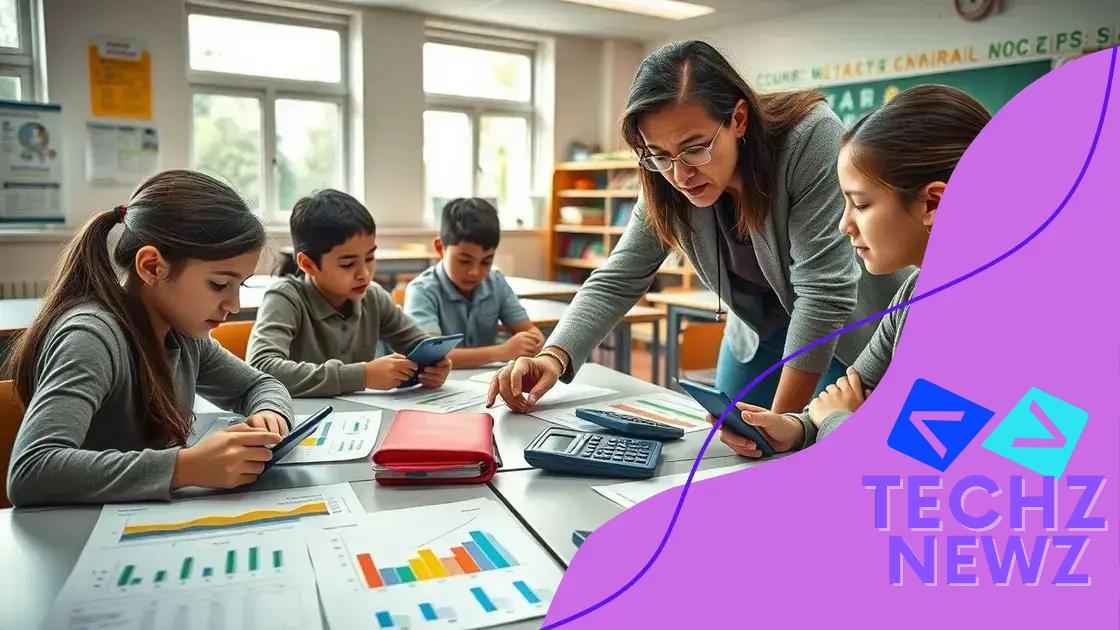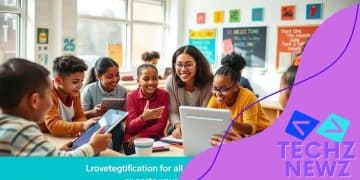Financial literacy education for high school seniors

Financial literacy education for high school seniors provides essential skills in budgeting, saving, and investing, empowering students to make informed financial decisions for their futures.
Financial literacy education for high school seniors plays a crucial role in preparing students for adult life. Have you ever wondered how managing money affects future opportunities? In this article, we’ll delve into effective strategies and tips for enhancing financial understanding among young adults.
Understanding the importance of financial literacy
Understanding the importance of financial literacy is essential for young adults. It equips them with the tools to make informed financial decisions. This foundation can lead to a secure and prosperous future. While many students may find money management boring, the truth is it can be quite empowering.
Why Financial Literacy Matters
Financial literacy helps students grasp how to manage their money effectively. It promotes confidence when dealing with financial matters, such as budgeting, saving, and investing.
Benefits of Being Financially Literate
Students who are financially literate can:
- Make smarter choices regarding spending
- Avoid debts that can hinder progress
- Plan for future goals, like college or buying a car
- Understand the importance of savings and investments
Grasping these concepts will prepare them not just for immediate financial choices but for major life decisions. For instance, understanding how interest rates work can save them money in the long run.
Creating a Financial Plan
Teaching students to create a financial plan is vital. They should learn to set goals, budget their income, and track their expenses. This practical approach gives them real-world skills.
By incorporating financial literacy in their education, schools encourage a culture of responsible financial behavior. For many, this may be the first exposure to managing money, and it can be a life-changing skill.
Incorporating engaging activities like budgeting games can make learning fun and practical. This type of hands-on experience can cement the importance of financial literacy.
Key financial concepts every student should know
Understanding key financial concepts is fundamental for students as they prepare for adult life. These concepts help make sense of financial choices they will face, and they empower them to take control of their financial futures. Knowing terms like budgeting, saving, and investing can spark interest in managing money.
Essential Financial Concepts
Every student should grasp the following concepts:
- Budgeting: This involves creating a plan for how to spend money wisely. It helps students see where their money goes and how to prioritize their expenses.
- Saving: Learning to save is critical for achieving financial goals. Setting aside a portion of money each month can build a safety net for emergencies.
- Investing: Understanding the basics of investing can open doors for students. It involves using money to purchase assets that are expected to grow in value over time.
- Credit: Knowing how credit works, including how to build a good credit score, is essential for future financial opportunities.
Grasping these concepts early can lead to better money management and preparedness for significant financial decisions later.
The Importance of Practical Learning
Beyond theoretical knowledge, giving students practical experiences can deepen their understanding. Activities like managing a mock budget or simulating investments can enhance learning. For example, playing games that involve financial decision-making can be engaging and educational.
Understanding key financial concepts fosters financial responsibility. Engaging lessons and real-life applications make the information stick, making students more likely to apply this knowledge in their lives.
Encouraging discussions about money management and financial concepts in the classroom can spark interest. Students should feel comfortable asking questions and exploring these concepts further.
Practical tips for teaching budgeting skills

Teaching budgeting skills is vital for students to understand how to manage their money wisely. With practical tips, educators can create engaging lessons that resonate with high school seniors. Making budgeting relatable ensures that students appreciate its importance in their daily lives.
Key Techniques for Effective Budgeting Lessons
Here are some effective techniques to teach budgeting skills:
- Use real-life scenarios: Presenting students with common financial situations, like saving for a trip or managing expenses during college, can make budgeting feel relevant.
- Incorporate technology: Use budgeting apps or spreadsheets during lessons. This hands-on approach helps students familiarize themselves with tools they can use outside the classroom.
- Set financial goals: Encourage students to set realistic financial goals. This could be saving a certain amount each month. Goal-setting motivates them to stick to their budgets.
- Class discussions: Create forums to discuss challenges in budgeting. Sharing experiences and solutions fosters a collaborative learning environment.
Integrating these practical tips engages students and provides them essential skills. When students actively participate, they are more likely to retain the information and apply it in real-world situations.
Implementing Budgeting Activities
Budgeting activities can make learning interactive. For instance, simulating a month’s worth of expenses can help students practice creating a budget. They can track hypothetical income and allocate funds to different categories like food, entertainment, and savings.
Through these activities, students learn to prioritize spending and make informed decisions. Reinforcing the importance of tracking expenses can lead to better financial habits.
Ultimately, teaching budgeting skills is about equipping students with the knowledge they need for the future. By using practical tips and engaging activities, educators can foster a positive attitude toward money management.
Exploring investment basics for beginners
Exploring investment basics is an exciting step for students moving into the world of finance. Understanding how investing works can provide students with the tools to grow their wealth. It opens the door to new opportunities and helps them prepare for a financially secure future.
What is Investing?
Investing involves putting money into assets with the expectation of generating a profit. This can include stocks, bonds, real estate, and more. It’s important for students to realize that all investments carry risks, but they also offer the potential for returns.
Types of Investments
There are several types of investments that beginners should know:
- Stocks: Buying shares in a company makes you a part-owner. Stocks can offer high returns but come with higher risk.
- Bonds: These are loans made to companies or governments, paying interest over time. They tend to be less risky than stocks.
- Mutual Funds: These pools of money are managed by professionals, allowing for diverse investments in stocks and bonds.
- Real Estate: Investing in property can provide rental income and potential appreciation in value.
Each type of investment has its characteristics and suits different financial goals. Students should explore various options to find what aligns with their interests.
Getting Started with Investing
To start investing, students can begin by educating themselves about the market. Resources such as books, seminars, and online courses can provide essential knowledge. Opening a brokerage account is another practical step. This gives them access to buy and sell investments.
Setting clear financial goals is crucial. Students should ask themselves what they want to achieve with their investments. Long-term goals, like saving for college or a car, require a different approach than short-term goals, like saving for a vacation.
Investing can seem complex at first, but the basics are manageable with proper guidance. Through lessons and practical experiences, students can develop a strong foundation in this field, paving the way for their financial futures.
Resources for enhancing financial literacy in schools
Resources for enhancing financial literacy in schools play a significant role in equipping students with essential life skills. These tools and materials can foster an engaging learning environment and spark students’ interest in financial education. By utilizing various resources, educators can make complex concepts easier to understand and apply.
Types of Resources Available
There are numerous resources available for schools to enhance financial literacy:
- Online Courses: Websites like Khan Academy and Coursera offer free courses on personal finance basics. These platforms provide valuable lessons students can access anytime.
- Financial Literacy Programs: Organizations like Jump$tart and the National Endowment for Financial Education offer structured programs that schools can implement. These programs often include lesson plans, activities, and assessments.
- Books and eBooks: A variety of books are available on personal finance topics. Titles like “The Total Money Makeover” provide relatable stories and practical advice.
- Interactive Games: Gamifying financial education can make learning fun. Apps and board games like ‘Monopoly’ or ‘The Game of Life’ teach money management in an engaging way.
Using these resources, teachers can create a comprehensive financial literacy curriculum that resonates with students. Bringing real-life examples into lessons can enhance understanding and retention.
Involving the Community
Schools can also partner with local businesses and financial institutions. Guest speakers from the community can share their experiences and offer insights into practical finance. Organizing workshops or seminars can enrich the learning experience and connect students with professionals.
Parents can play a role as well. Providing resources for families helps facilitate discussions about money management at home. When students engage with their families about finance, it reinforces what they’ve learned in school.
Enhancing financial literacy in schools is not just about teaching students how to manage money. It’s about preparing them for their futures, making informed decisions, and building a solid foundation for lifelong financial health. By incorporating diverse resources, schools can create an effective and engaging learning environment.
FAQ – Frequently Asked Questions about Financial Literacy Education
Why is financial literacy important for high school seniors?
Financial literacy is crucial for high school seniors as it equips them with essential money management skills, helping them make informed financial decisions in their future.
What are some key concepts students should learn?
Students should learn budgeting, saving, investing, and understanding credit to build a strong financial foundation.
How can schools enhance financial literacy programs?
Schools can enhance financial literacy by incorporating engaging resources like online courses, interactive games, and community partnerships.
What role do parents play in their children’s financial education?
Parents can reinforce financial concepts at home, assisting their children in making real-world applications of what they learn in school.





